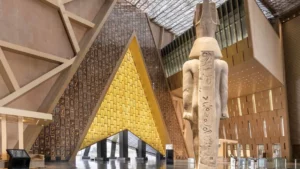Four Well-Preserved Roman-Era Swords Found in Israeli Cave

Archaeologists have found four 1,900-year-old swords in a small cave located in an area of isolated and inaccessible cliffs north of the archaeological site of ‘Ein Gedi in the Judean Desert Nature Reserve, Israel.
About five decades ago, Israeli archaeologists found a stalactite with a fragmentary ink inscription written in ancient Hebrew script in this cave.
Ariel University’s Dr. Asaf Gayer and colleagues recently visited the cave to photograph the inscription with multispectral photography.
While on the upper level of the cave, Dr. Gayer spotted an extremely well-preserved, Roman pilum — a shafted weapon in a deep narrow crevice.
He also found pieces of worked wood in an adjacent niche that turned out to be parts of the swords’ scabbards.
Further examination by a team of archaeologists from the Israel Antiquities Authority revealed four Roman swords in an almost inaccessible crevice on the upper level of the cave.
The swords were exceptionally well preserved, and three were found with iron blades inside the wooden scabbards.
Leather strips and wooden and metal finds belonging to the weapons were also found in the crevice.
The weapons had well-fashioned handles made of wood or metal.
“The length of the blades of three swords was 60-65 cm (24-25.5 inches), their dimensions identifying them as Roman spatha swords,” the archaeologists explained.
“The fourth one was shorter with a 45-cm- (17.7-inch) long blade, identified as a ring-pommel sword.”
The initial examination of the artifacts confirmed that these were standard swords employed by the Roman soldiers stationed in Judea in the Roman period.
“The hiding of the swords and the pilum in deep cracks in the isolated cave north of ‘Ein Gedi, hints that the weapons were taken as booty from Roman soldiers or from the battlefield, and purposely hidden by the Judean rebels for reuse,” said Dr. Eitan Klein, one of the directors of the Judean Desert Survey Project.
“Obviously, the rebels did not want to be caught by the Roman authorities carrying these weapons.”
“We are just beginning the research on the cave and the weapon cache discovered in it, aiming to try to find out who owned the swords, and where, when, and by whom they were manufactured.”
“We will try to pinpoint the historical event that led to the caching of these weapons in the cave and determine whether it was at the time of the Bar Kokhba Revolt in 132-135 CE.”
Additionally, the researchers unearthed artifacts dating to the Chalcolithic period (c. 6,000 years ago) and the Roman period (c. 2,000 years ago) in the cave.
“At the entrance to the cave, a Bar-Kokhba bronze coin from the time of the Revolt was found, possibly pointing to the time when the cave served for concealing the weapons,” they said.
Source : SCI News





